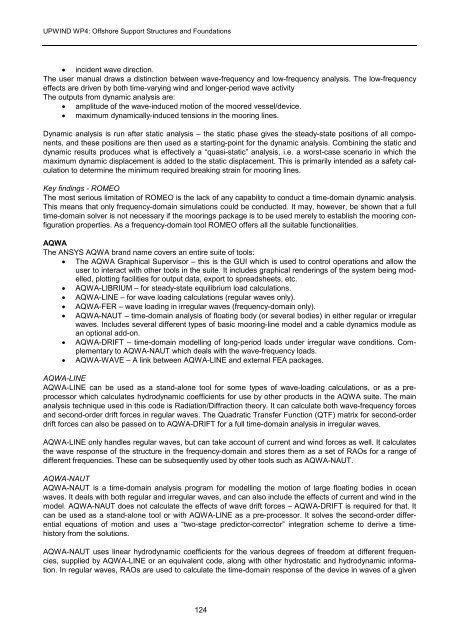Final report for WP4.3: Enhancement of design methods ... - Upwind
Final report for WP4.3: Enhancement of design methods ... - Upwind
Final report for WP4.3: Enhancement of design methods ... - Upwind
Create successful ePaper yourself
Turn your PDF publications into a flip-book with our unique Google optimized e-Paper software.
UPWIND WP4: Offshore Support Structures and Foundations<br />
• incident wave direction.<br />
The user manual draws a distinction between wave-frequency and low-frequency analysis. The low-frequency<br />
effects are driven by both time-varying wind and longer-period wave activity<br />
The outputs from dynamic analysis are:<br />
• amplitude <strong>of</strong> the wave-induced motion <strong>of</strong> the moored vessel/device.<br />
• maximum dynamically-induced tensions in the mooring lines.<br />
Dynamic analysis is run after static analysis – the static phase gives the steady-state positions <strong>of</strong> all components,<br />
and these positions are then used as a starting-point <strong>for</strong> the dynamic analysis. Combining the static and<br />
dynamic results produces what is effectively a “quasi-static” analysis, i.e. a worst-case scenario in which the<br />
maximum dynamic displacement is added to the static displacement. This is primarily intended as a safety calculation<br />
to determine the minimum required breaking strain <strong>for</strong> mooring lines.<br />
Key findings - ROMEO<br />
The most serious limitation <strong>of</strong> ROMEO is the lack <strong>of</strong> any capability to conduct a time-domain dynamic analysis.<br />
This means that only frequency-domain simulations could be conducted. It may, however, be shown that a full<br />
time-domain solver is not necessary if the moorings package is to be used merely to establish the mooring configuration<br />
properties. As a frequency-domain tool ROMEO <strong>of</strong>fers all the suitable functionalities.<br />
AQWA<br />
The ANSYS AQWA brand name covers an entire suite <strong>of</strong> tools:<br />
• The AQWA Graphical Supervisor – this is the GUI which is used to control operations and allow the<br />
user to interact with other tools in the suite. It includes graphical renderings <strong>of</strong> the system being modelled,<br />
plotting facilities <strong>for</strong> output data, export to spreadsheets, etc.<br />
• AQWA-LIBRIUM – <strong>for</strong> steady-state equilibrium load calculations.<br />
• AQWA-LINE – <strong>for</strong> wave loading calculations (regular waves only).<br />
• AQWA-FER – wave loading in irregular waves (frequency-domain only).<br />
• AQWA-NAUT – time-domain analysis <strong>of</strong> floating body (or several bodies) in either regular or irregular<br />
waves. Includes several different types <strong>of</strong> basic mooring-line model and a cable dynamics module as<br />
an optional add-on.<br />
• AQWA-DRIFT – time-domain modelling <strong>of</strong> long-period loads under irregular wave conditions. Complementary<br />
to AQWA-NAUT which deals with the wave-frequency loads.<br />
• AQWA-WAVE – A link between AQWA-LINE and external FEA packages.<br />
AQWA-LINE<br />
AQWA-LINE can be used as a stand-alone tool <strong>for</strong> some types <strong>of</strong> wave-loading calculations, or as a preprocessor<br />
which calculates hydrodynamic coefficients <strong>for</strong> use by other products in the AQWA suite. The main<br />
analysis technique used in this code is Radiation/Diffraction theory. It can calculate both wave-frequency <strong>for</strong>ces<br />
and second-order drift <strong>for</strong>ces in regular waves. The Quadratic Transfer Function (QTF) matrix <strong>for</strong> second-order<br />
drift <strong>for</strong>ces can also be passed on to AQWA-DRIFT <strong>for</strong> a full time-domain analysis in irregular waves.<br />
AQWA-LINE only handles regular waves, but can take account <strong>of</strong> current and wind <strong>for</strong>ces as well. It calculates<br />
the wave response <strong>of</strong> the structure in the frequency-domain and stores them as a set <strong>of</strong> RAOs <strong>for</strong> a range <strong>of</strong><br />
different frequencies. These can be subsequently used by other tools such as AQWA-NAUT.<br />
AQWA-NAUT<br />
AQWA-NAUT is a time-domain analysis program <strong>for</strong> modelling the motion <strong>of</strong> large floating bodies in ocean<br />
waves. It deals with both regular and irregular waves, and can also include the effects <strong>of</strong> current and wind in the<br />
model. AQWA-NAUT does not calculate the effects <strong>of</strong> wave drift <strong>for</strong>ces – AQWA-DRIFT is required <strong>for</strong> that. It<br />
can be used as a stand-alone tool or with AQWA-LINE as a pre-processor. It solves the second-order differential<br />
equations <strong>of</strong> motion and uses a “two-stage predictor-corrector” integration scheme to derive a timehistory<br />
from the solutions.<br />
AQWA-NAUT uses linear hydrodynamic coefficients <strong>for</strong> the various degrees <strong>of</strong> freedom at different frequencies,<br />
supplied by AQWA-LINE or an equivalent code, along with other hydrostatic and hydrodynamic in<strong>for</strong>mation.<br />
In regular waves, RAOs are used to calculate the time-domain response <strong>of</strong> the device in waves <strong>of</strong> a given<br />
124











